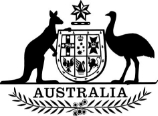
Therapeutic Goods (Serious Scarcity and Substitutable Medicine) (Labetalol) Instrument 2025
I, Nicholas Henderson, as delegate of the Minister for Health and Ageing, make the following instrument.
Dated 21 August 2025
Nicholas Henderson
First Assistant Secretary
Medicines Regulation Division
Health Products Regulation Group
Department of Health, Disability and Ageing
Contents
1 Name
2 Commencement
3 Authority
4 Definitions
5 Declaration of serious scarcity
6 Substitution of scarce medicine by pharmacists
7 Period instrument in force
8 Repeals
Schedule 1—Scarce medicine, substitutable medicine, dose unit equivalence and specific permitted circumstances
Schedule 2—General permitted circumstances
1 Name
This instrument is the Therapeutic Goods (Serious Scarcity and Substitutable Medicine) (Labetalol) Instrument 2025.
2 Commencement
(1) Each provision of this instrument specified in column 1 of the table commences, or is taken to have commenced, in accordance with column 2 of the table. Any other statement in column 2 has effect according to its terms.
Commencement information |
Column 1 | Column 2 | Column 3 |
Provisions | Commencement | Date/Details |
1. The whole of this instrument | 26 August 2025. | 26 August 2025 |
Note: This table relates only to the provisions of this instrument as originally made. It will not be amended to deal with any later amendments of this instrument.
(2) Any information in column 3 of the table is not part of this instrument. Information may be inserted in this column, or information in it may be edited, in any published version of this instrument.
3 Authority
This instrument is made under section 30EK of the Therapeutic Goods Act 1989.
4 Definitions
Note: A number of expressions used in this instrument are defined in subsection 3(1) of the Act, including the following:
(a) medicine;
(b) pharmacist;
(c) registration number.
In this instrument:
Act means the Therapeutic Goods Act 1989.
prescriber means the person who:
(a) is authorised under a law of a State or Territory to prescribe medicine, and
(b) prescribed the scarce medicine for the patient.
scarce medicine has the meaning given by section 5.
substitutable medicine has the meaning given by section 6.
tablet has the same meaning as in the Therapeutic Goods (Standard for Tablets, Capsules and Pills) (TGO 101) Order 2019.
Note: TGO 101 is a legislative instrument published on the Federal Register of Legislation at www.legislation.gov.au.
5 Declaration of serious scarcity
For paragraph 30EK(1)(a) of the Act, a serious scarcity of the medicine specified in column 2 of each item in the table in Schedule 1 (the scarce medicine) across the whole of Australia is declared.
6 Substitution of scarce medicine by pharmacists
For paragraph 30EK(1)(b) of the Act, in relation to each item in the table in Schedule 1, the medicine specified in column 3 (the substitutable medicine) is permitted to be dispensed by a pharmacist in substitution for the scarce medicine specified in column 2, in the circumstances specified in:
(a) column 5 of that item (the specific permitted circumstances); and
(b) the table in Schedule 2 (the general permitted circumstances).
Note: Substitution is only permitted where both the specific permitted circumstances and the general permitted circumstances exist.
7 Period instrument in force
This instrument remains in force until 31 October 2025.
8 Repeals
Unless repealed earlier, this instrument is repealed at the start of 1 November 2025.
Schedule 1—Scarce medicine, substitutable medicine, dose unit equivalence and specific permitted circumstances
Note: See sections 5 and 6.
Scarce medicine, substitutable medicine, dose unit equivalence and specific permitted circumstances |
Column 1 | Column 2 | Column 3 | Column 4 | Column 5 |
Item | Scarce medicine | Substitutable medicine | Dose unit equivalence | Specific permitted circumstances |
1 | PRESOLOL 100 labetalol hydrochloride 100 mg tablet bottle, registration number 56475 | PRESOLOL 200 labetalol hydrochloride 200 mg tablet bottle, registration number 56476 | half a tablet of the substitutable medicine is equivalent to one tablet of the scarce medicine | the pharmacist has advised the patient, or person acting on behalf of the patient: (a) of the number of dose units of substitutable medicine that must be taken by the patient in substitution for the prescribed dose of scarce medicine, based on the dose unit equivalence in column 4; and (b) where cutting of the tablet is required to obtain the correct dose of the substitutable medicine—of suitable instructions for cutting the tablet; and (c) of the differences between the scarce medicine and the substitutable medicine; and (d) either: (i) of suitable instructions for administering the substitutable medicine; or (ii) to obtain instructions for administering the substitutable medicine from the prescriber or a general practitioner |
Schedule 2—General permitted circumstances
Note: See section 6.
General permitted circumstances |
Column 1 | Column 2 |
Item | Circumstances |
1 | the patient, or person acting on behalf of the patient, has evidence of a valid prescription for the scarce medicine, unless otherwise permitted by law |
2 | the pharmacist does not have access to the scarce medicine |
3 | the prescriber has not indicated on the prescription for the scarce medicine that substitution is not permitted |
4 | the pharmacist has exercised professional judgement and determined that the patient is suitable to receive the substitutable medicine |
5 | the amount of substitutable medicine dispensed would result in the patient receiving sufficient medicine to ensure an equivalent dosage regimen and duration to that prescribed in relation to the scarce medicine |
6 | the patient, or person acting on behalf of the patient, has consented to receiving the substitutable medicine |
7 | the pharmacist makes a record of dispensing the substitutable medicine in substitution of the scarce medicine at the time of dispensing |
8 | the pharmacist has an established procedure to notify the prescriber of the substitution at the time of, or as soon as practical after, dispensing the substitutable medicine |
